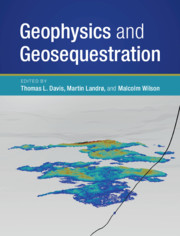Book contents
- Geophysics and Geosequestration
- Geophysics and Geosequestration
- Copyright page
- Contents
- Contributors
- Preface
- Acknowledgments
- Abbreviations
- Part I Introduction
- Part II Geophysical Techniques
- Part III Case Studies
- Chapter 12 Offshore Storage of CO2 in Norway
- Chapter 13 Twenty Years of Monitoring CO2 Injection at Sleipner
- Chapter 14 Case Studies of the Value of 4D, Multicomponent Seismic Monitoring in CO2 Enhanced Oil Recovery and Geosequestration
- Chapter 15 Integrated Geophysical Characterization and Monitoring at the Aquistore CO2 Storage Site
- Chapter 16 Development and Analysis of a Geostatic Model for Shallow CO2 Injection at the Field Research Station, Southern Alberta, Canada
- Chapter 17 Seismic and Electrical Resistivity Tomography 3D Monitoring at the Ketzin Pilot Storage Site in Germany
- Chapter 18 Time-Lapse Seismic Analysis of the CO2 Injection into the Tubåen Formation at Snøhvit
- Chapter 19 Illinois Basin–Decatur Project
- Part IV Summary
- Index
- References
Chapter 18 - Time-Lapse Seismic Analysis of the CO2 Injection into the Tubåen Formation at Snøhvit
from Part III - Case Studies
Published online by Cambridge University Press: 19 April 2019
- Geophysics and Geosequestration
- Geophysics and Geosequestration
- Copyright page
- Contents
- Contributors
- Preface
- Acknowledgments
- Abbreviations
- Part I Introduction
- Part II Geophysical Techniques
- Part III Case Studies
- Chapter 12 Offshore Storage of CO2 in Norway
- Chapter 13 Twenty Years of Monitoring CO2 Injection at Sleipner
- Chapter 14 Case Studies of the Value of 4D, Multicomponent Seismic Monitoring in CO2 Enhanced Oil Recovery and Geosequestration
- Chapter 15 Integrated Geophysical Characterization and Monitoring at the Aquistore CO2 Storage Site
- Chapter 16 Development and Analysis of a Geostatic Model for Shallow CO2 Injection at the Field Research Station, Southern Alberta, Canada
- Chapter 17 Seismic and Electrical Resistivity Tomography 3D Monitoring at the Ketzin Pilot Storage Site in Germany
- Chapter 18 Time-Lapse Seismic Analysis of the CO2 Injection into the Tubåen Formation at Snøhvit
- Chapter 19 Illinois Basin–Decatur Project
- Part IV Summary
- Index
- References
- Type
- Chapter
- Information
- Geophysics and Geosequestration , pp. 319 - 338Publisher: Cambridge University PressPrint publication year: 2019
References
- 1
- Cited by



